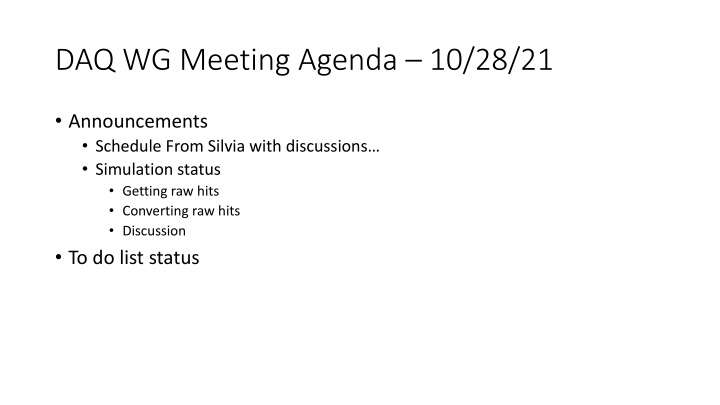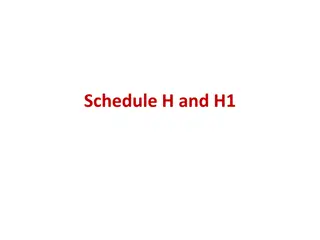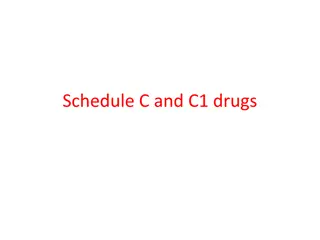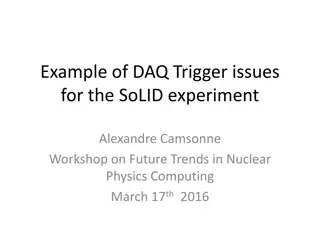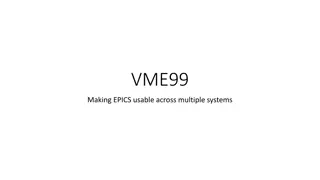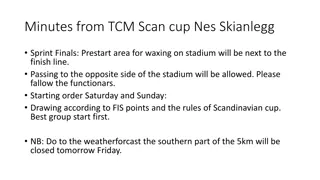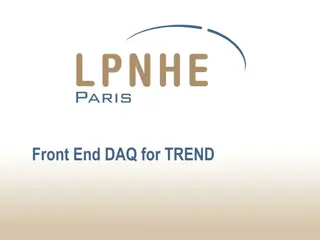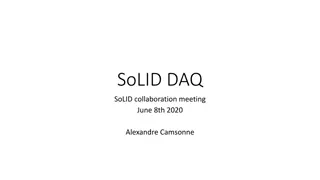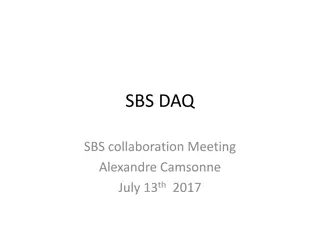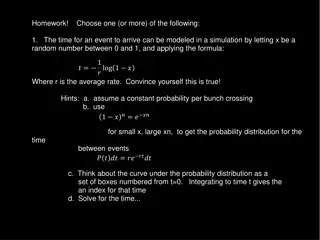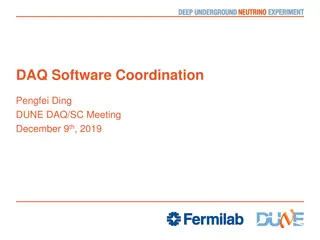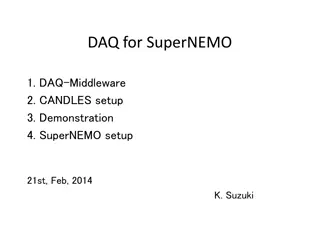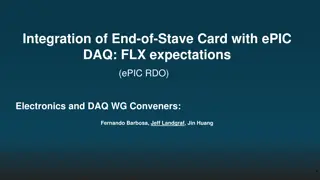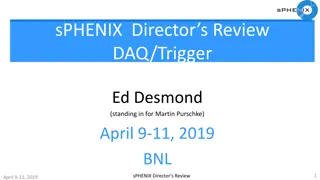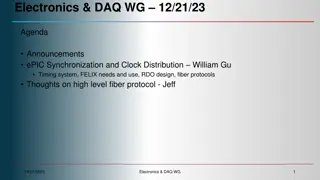DAQ WG Meeting Agenda 10/28/21 Announcements and Schedule
Agenda for the DAQ WG meeting on 10/28/21 includes announcements, schedule updates, discussions on simulation status, getting raw hits, converting raw hits, to-do list updates, and more. The document also covers costing discussions, proposed figure modifications, data rate figures, and simulation status reports on data sizes and evaluation of calorimeter raw hits.
Download Presentation

Please find below an Image/Link to download the presentation.
The content on the website is provided AS IS for your information and personal use only. It may not be sold, licensed, or shared on other websites without obtaining consent from the author.If you encounter any issues during the download, it is possible that the publisher has removed the file from their server.
You are allowed to download the files provided on this website for personal or commercial use, subject to the condition that they are used lawfully. All files are the property of their respective owners.
The content on the website is provided AS IS for your information and personal use only. It may not be sold, licensed, or shared on other websites without obtaining consent from the author.
E N D
Presentation Transcript
DAQ WG Meeting Agenda 10/28/21 Announcements Schedule From Silvia with discussions Simulation status Getting raw hits Converting raw hits Discussion To do list status
Announcements (Page 1) Schedule from Silvia Figure data must be close (simulations crucial) Supplemental Materials Draft Now (Draft Text and figures)
Schedule (Draft text) Draft (submitted but still no comments or revisions seen) Global Overleaf. We should read the detector versions and see what overlap there is, or needs to be Costing Draft New last costing meeting: there is a 1.5 page costing explanation. Guidance on what this will contain has not yet been specified, but for us: Discussion of the assumptions that go into aggregation & the nature of the overlap between the detectors and DAQ in this regard. (ie.) where detector groups haven t specified electronics design for full aggregation we cover that assumption using the FELIX pricing as a default. Discussion of assumptions that go into labor Discussion of purpose and scale of 3 layers of DAQ computing Discussion of the potential risks/uncertainty in regard to the need for developing data reduction algorithms for the RICH detectors. The costing group is going to be very interested in specifying in-kind contributions, I don t think we have any. Should this part of the proposal should mention the project part of the development (eg the FELIX boards)?
Schedule (Data Rate Figure): This figure needs to be cleaned up: Obviously, the plot has to be legible and clear, but that has been waiting on valid data, but in scheme: 1. How many detectors should be listed? 2. Is the inset scheme the right one for indicating the vast difference between the RICH input rates vs output rate as compared to the other detectors (and illustrate the issue with the DAQ)? Go to some other scheme? Keep the bar graph but put input/output next to each other?
Simulation Status: Getting the data sizes: The actual conversion to data volume is what we need: The scheme of getting the raw hits is implemented as part of physics benchmarks Reported that this was in place, and is for calorimeters, but not for other detectors. S&C has no time. I have the file that needs editing, and list of detector names, and examples and will need 3-4 hours + to implement and figure out how to get the code in. I intend to do this before the S&C office hours tomorrow, and hopefully we can see results this weekend.
Simulation Status: Evaluation of the Calorimeter Raw hits Simple evaluation gives about 90gbps coming from the calorimeters Use the 500khz base rate from 275x10GeV p+e collisions The event size is very consistent for all 41x5, 100x10, 275x18. 275x10 not actually available Au+e not available However, Do hits correspond to SiPM hits? Or to hits within the tower layers Thresholds? So current scheme assumes 90gbps. If the occupancy is that high, then we can get significant data reduction by gathering in the DAQ the hits from the same time, and avoiding writing the time with all hits, for example, so this would allow significant reduction ~x2, and other schemes could also help, so with no additional analysis: 90gbps max input rate 30gbps max output rate However! Needs better analysis than this! This illustrates how far we are from valid simulation based event sizes.
To do list for Nov 1 Get solid occupancy / hit counts from simulation [needed for proposal plot] Synchrotron radiation [In Progress] Collisions [Awaiting analysis ] Beam gas [Project generator, but not started] Detector Data Volume (Collission) Data Volume (Synchrotron) Data Volume (Beam Gas) Data Volume (Noise) Si Tracker X MPGD Tracker X dRICH X ( ) Decide how to proceed with regard to low data volume FELIX [Discuss at project meeting] Assume/or verify aggregation close to data volume in the end [Verify send each WG our current assumptions, and biggest issues/plans with specific detectors] Propose cheaper aggregation to go into FELIX [Done: Take this out of plan with regard to proposal, if not with regard to reality] Propose R&D goals for FELIX a simpler parallel version [Done: Take out of plan with regard to proposal] Labor costing estimate iteration: current estimate 29 FTE total. [In progress / Feedback from Athena & project planned] Global Timing System actual costing [made up numbers, possibly ok, need to run experts] System diagram [Have editable version, Still need to update] Proposal text iteration https://www.overleaf.com/4462197242wshdzrtdvhcm [Awaiting feedback, may send update with explanation] Costing official spreadsheets [In progress, regular scheduled updates with Bernd/Zhangbu/James] Supplemental materials (needs to be considered, brief, and of equally high quality to proposal) [Not yet started, will produce outline]
